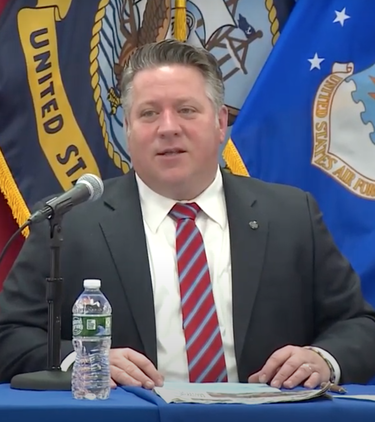Albany County will not add more categories of essential workers to get vaccinated
— Still frame from from Feb. 4 Albany County press conference video
Workers at the county’s board of elections had a recent outbreak of COVID-19 but aren’t eligible for vaccinations, Albany County Executive Daniel McCoy said on Thursday. McCoy went on to name a half-dozen county departments — the clerk’s office, human resources, finance, mental health, public works, and social services — where workers are not eligible for shots.
ALBANY COUNTY — Local health departments can add to the list of categories of essential workers eligible to receive COVID-19 vaccinations, Governor Andrew Cuomo said on Feb. 2
“If a local health department, county government wants to add to their — what’s called 1b — prioritization, if they want to add developmentally disabled facilities, if they want to add taxi drivers, Uber drivers, restaurant workers, they can do that if they think it works within their prioritization locally,” Cuomo said at his press briefing on Tuesday.
On Thursday, Albany County Executive Daniel McCoy said, “We will not be opening that up here … We still have people in 1b and 1a that have not got shots. We still have a lot of seniors over 65 and 75 that have not gotten shots.”
At the same time, McCoy reiterated his concerns about his sister-in-law, in her forties, with ALS or amyotrophic lateral sclerosis, often called Lou Gehrig’s disease because of the baseball player who had ALS. It is a progressive nervous-system disease that causes loss of muscle control.
“She can’t get out of the house, can’t move, talks through a machine. Been living with this for about a decade now,” said McCoy of his sister-in-law.
He also said, “She can’t get a shot. I can’t get her a shot.”
He continued, “This disease has crippled more people with underlying health issues … We need to address that.”
McCoy went on to say that he is not eligible to get vaccinated under 1a — primarily for nursing home workers and residents and public-facing health-care workers — or 1b, which is for essential workers like police, firefighters, and teachers as well as for people 65 and older.
Workers at the county’s board of elections, which, McCoy said, had a recent outbreak of COVID-19 aren’t eligible for vaccinations. McCoy went on to name a half-dozen county departments — the clerk’s office, human resources, finance, mental health, public works, and social services — where workers are not eligible for shots.
Those workers, he said, have been dealing “face to face” with the public for the last 11 months.
We need to define this better,” said McCoy.
He also said, “I don’t want to say someone delivering food is more essential than me or the chair of the legislature but we gotta do what’s right to continue to move government forward.”
He also said, “I want to see the people most vulnerable … get the shot first.”
McCoy said that Andrew Joyce, who chairs the county legislature, and himself could, as combat veterans, get vaccinated through the military.
“But you gotta lead by example,” McCoy concluded.
Newest numbers
McCoy opened Thursday morning’s press conference by announcing two more COVID-related deaths of county residents; both of the latest victims were women in their eighties.
This brings the county’s COVID-19 death toll to 324.
“You can’t be by their side when they take their last breath,”said Mccoy of the difficulties of death in the midst of the pandmci.
For the last several days, the county’s number of new cases had dipped below 100 but that trend was broken Thursday as McCoy announced 155 new cases, bringing the county’s total, since last March, to 18,716 confirmed COVID-19 cases.
McCoy said the earlier drop may have been because state testing sites had shut down during the snowstorm on Monday and Tuesday.
Of the new cases, 91 did not have clear sources of infection identified, 49 had close contact with someone infected with the disease, 13 were health-care workers or residents of congregate settings, and two traveled out of state.
The five-day average for new daily positives has decreased to 112.8 from 119.4. There are now 1,220 active cases in the county, down from 1,246 yesterday.
The number of Albany County residents under mandatory quarantine increased to 2,511 from 2,400. So far, 56,341 residents have completed quarantine. Of those, 17,496 had tested positive and recovered. That is an increase of 174 recoveries since yesterday.
There were 12 new hospitalizations overnight, and there are 126 county residents currently hospitalized from the virus — a net decrease of four. There are still 16 patients in intensive-care units.
“Unfortunately, it’s our hospitalizations that still continue to haunt us here in the Capital District, especially here in Albany County,” said McCoy.
Among the state’s 10 regions, Albany County continues to have the worst rates for available hospital beds and available ICU beds.
According to a Thursday release from the governor’s office, 392 Capital Region residents are hospitalized with COVID-19, which is 0.04 percent of the region’s population and leaves 27 percent of its hospital beds available, a slightly higher percentage than in recent weeks.
Statewide, 0.04 percent of New Yorkers are hospitalized with the virus, leaving 34 percent of hospital beds available.
The percentage of available ICU beds in the Capital Region decreased to 17 percent as currently 216 of the 247 ICU beds are filled.
Statewide, 26 percent of ICU beds are available.
The Capital Region’s infection rate, as of Wednesday, as a seven-day average, was 4.11 percent. Statewide, the positivity rate was 4.72 percent.
Albany County, as of Wednesday, had an infection rate, as a seven-day rolling average, of 4.9 percent, according to the state’s dashboard.
According to a Thursday release from the governor’s office, the Capital Region has administered 116,396 of the 137,840 vaccine doses it has been given, which is 84 percent.
Statewide, 81 percent of doses have been administered.


